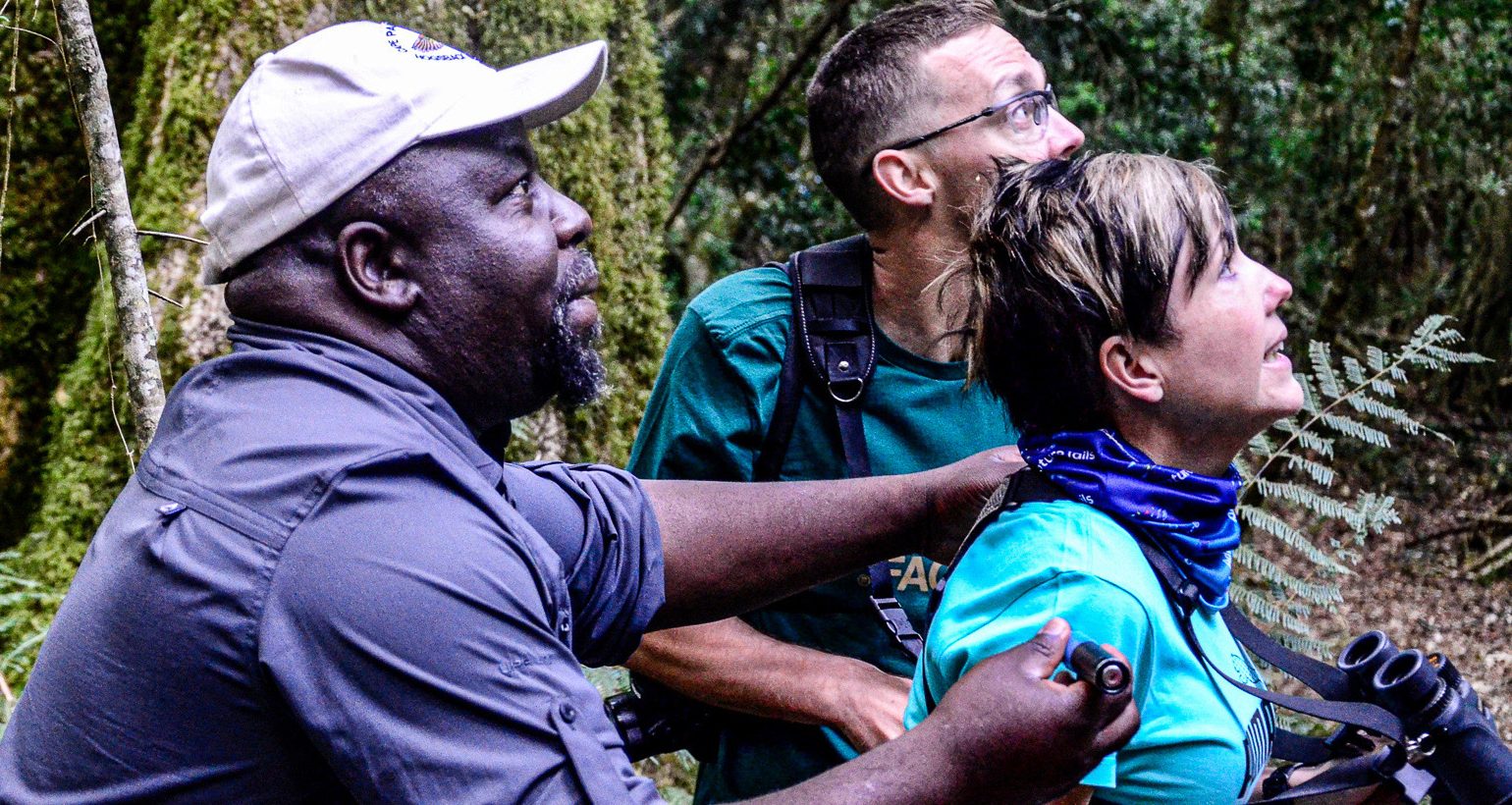
Bird guide David Letsoalo getting his East Rand guests Marize and Barry into position to see the black-fronted bush shrike. (Photo: Angus Begg)
By Angus Begg | 26 Apr 2022
Bird guides David Letsoalo and Samson Mulaudzi educate the public about their feathered friends and the vital roles they play in South Africa’s diverse ecosystems.
_______________________________________________________________________________________________________-______________________
I had to wait three years to experience the world of birds and biodiversity through the lens of David Letsoalo.
A resident of Makotopong, a village of 25,000 people some 20km outside Polokwane, with the Mall of the North its closest landmark, Letsoalo was voted by BirdLife South Africa as the country’s best bird guide in 2007.
I first met him while wearing my hat of a conservation and travel writer of some 20 years standing. We were exploring Limpopo activities and back roads, and Letsoalo was introduced as our guide for a jaunt through a chunk of the Woodbush — aka the more lyrically named Houtbos — state forest. That’s when I learnt that Woodbush was the second-largest tract of indigenous forest in South Africa.
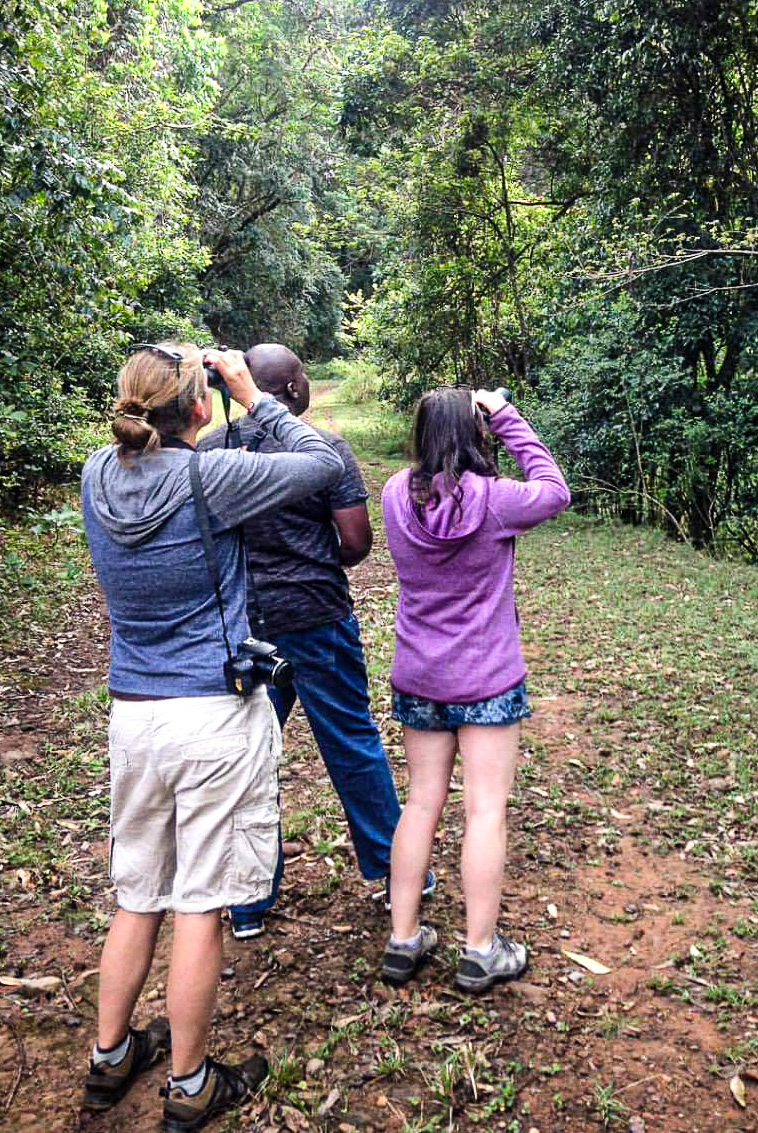
Birders will travel from all over South Africa and the world for the privilege of being guided by the likes of Samson and David. (Photo: Angus Begg)
“Good birds,” said Letsoalo, while dodging straining tree roots on the mulch-moist forest floor and occasionally glancing skywards into the tree canopy. “Very good birding.” But with so much organic forest life “happening” underfoot and among the ferns, which Letsoalo was interpreting for the group of visitors, there simply hadn’t been time to test his claim.
When I finally did, I found his knowledge of and enthusiasm for birdlife infectious, his vision astounding.
Letsoalo says he’s currently guiding about six times a month, and “a lot during the dry times”. From recent experience this makes sense. For as beautiful as the Woodbush and Magoebaskloof forests may be — and where he is a regular visitor — in the rain, birding beneath a wet and dripping canopy is often a non-event, restricted to the very occasional and daring “bird party”.
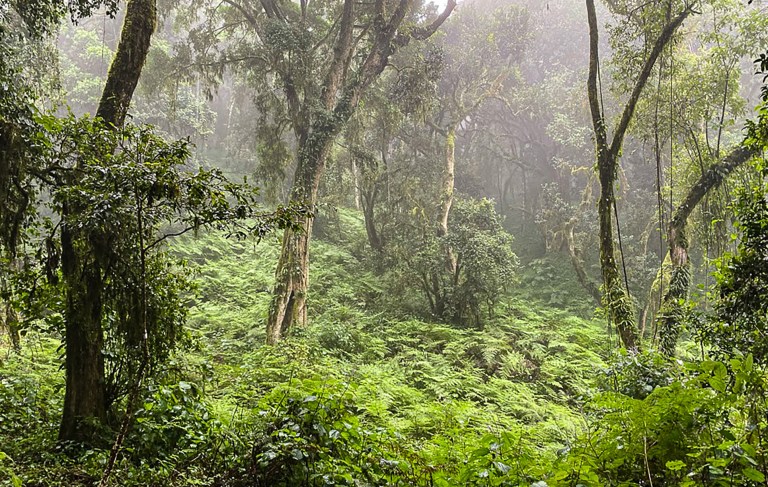
The thick forest of Woodbush, Houtbos, state forest. The trails are decent, but the signposting is in need of a little work. (Photo: Angus Begg)
A qualified motor mechanic and a potter, this Limpopo resident says being a professional bird guide is not so much a choice as a passion. “Birds are companions of human beings and indicators in most cases, as with a possible snake nearby, and there is a lot to learn from them.”
He speaks of certain species changing their environment as global warming marches through established climatic patterns, like the heat-loving puffadder being seen “at high altitude, where it is cold in winter”. This invites recollection of the arrival of the grey lourie — go-away bird — in Johannesburg after a major drought around 1992. And of course the irrepressible hadeda ibis.
Samson of the Soutpansberg
Far north in the Venda village of Tshivhazwaulu Maunavhathu, in the Vuwani area of Limpopo’s Vhembe municipality, birding guide Samson Mulaudzi says he can’t say birding is a good living. Like Letsoalo, he says he is busy “in season” — from October when the migrants return from up north — to March, when the swallows line up with military precision on the telegraph wires in preparation for take-off.
These birds have lifted his career. “It is a hobby to me and my profession. In fact, I spend my life in a healthy environment.”
Unlike Letsoalo, who guides nationally and is sometimes flown around the country by his clients, Mulaudzi is what the tourism world refers to as a “site guide”, specialising in his local area. Operating under the name of Birding Soutpansberg and Venda Tours, Mulaudzi says he was “just a caretaker and maintenance [sic] of a farm lodge” before he followed his passion, and quite possibly his dignity, 18 years ago and became a guide.
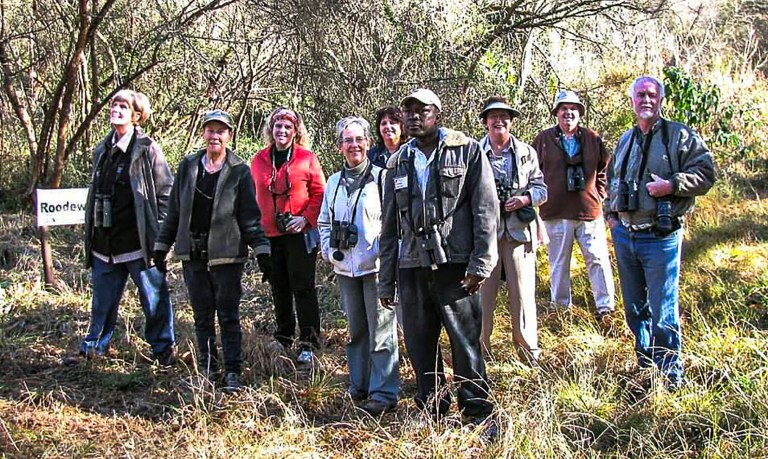
Samson Mulaudzi (front-centre) runs Birding Soutpansberg and Venda Tours, specialising in the birding Mecca of the Soutpansberg and northern Kruger Park. (Photo: Supplied)
“I grew up in nature; it is my passion. Birds are the most wonderful creatures in our ecosystem; an important part of our nature and environment, they teach us about seasonal and climate changes.”
Mulaudzi says he feels proud of himself, “especially when educating the young people about birds and their activities”.
Black sheep in Limpopo
But the former caretaker says his fellow villagers sometimes mock him when they see him leading a group of birders in his area.
“They will ask: ‘What are you doing with those binoculars?’ and when I say we are watching birds they laugh at me. But when I explain to them [where they’ve been and what they’ve been doing] they feel jealous.”
Letsoalo says when he arrived in Makotopong two years ago “people first thought I was crazy, and could not link looking at birds with work, but now that they know more about tourism, it seems to make sense to most”.
Being west of Thoyohandou, Mulaudzi’s home is far more rural than forested Magoebaskloof, closer to local destinations such as the Tshivhase Nature Reserve, with the game reserves and the bird-rich Pafuri area of the Kruger National Park not too far away.
Paying it forward
Both Letsoalo and Mulaudzi (51) say they have learnt a lot about their mutual passion, birds and the environment, from clients. Mulaudzi says his primary concern is when people litter. “You will find that a person throws away an empty can after he finishes drinking. That’s pollution.”
Letsoalo speaks about the environmental club he will start in Makotopong, his large village. “I think it will attract a lot of youth, with my main idea to open opportunities for them, to look into different [possible] paths of life, and to have knowledge about what is going on around them.”
The Limpopo oracles speak
He says his top two birding destinations are St Lucia in KwaZulu-Natal and Woodbush Forest Reserve in Magoebaskloof. The latter boasts names that get birding enthusiasts all a-flutter, such as black-fronted bushshrike — which looks infuriatingly like the orange-breasted bushshrike — “and the buff-spotted flufftail, Barratt’s warbler and bat hawk, to name but few”. Such names get the latest in luxury 4x4s heading north up the N1 in relative numbers, spending money that keeps Letsoalo in business.
As it does Mulaudzi, in the shadow of the eastern Soutpansberg, not far from the Tshakhuma fresh-produce market on the R524 linking Makhado to the Punda Maria entrance to the Kruger Park.
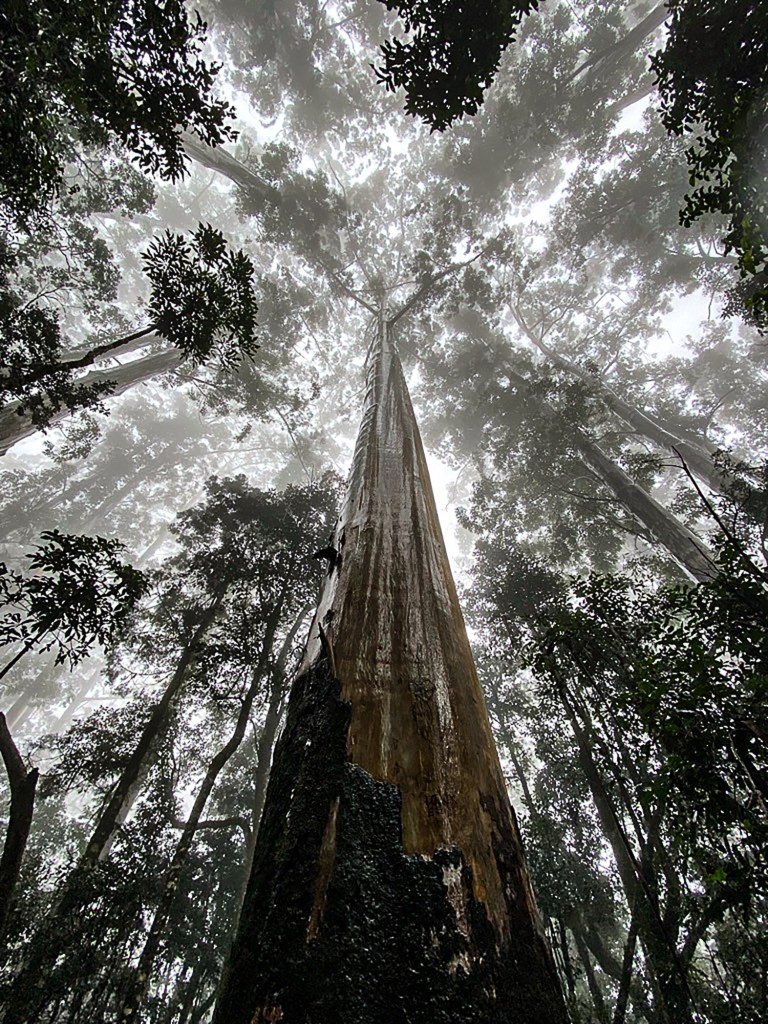
At 79 metres tall, this is Africa’s tallest planted tree. A eucaplytus seligna, planted by an Australian forester in Limpopo in 1906, with indigenous forest surrounding this and two other selignas. This is David Letsoalo’s world. (Photo: Angus Begg)
Odd encounters with relief workers in the ravaged Rwanda of 1994 remind me that fanatic, well-heeled birders globally will travel almost anywhere, in any conditions, to tick off unseen species. And barring the odd potholed rural roads, Limpopo is about as good and convenient as rural gets for twitchers adding to their tick-list.
“Not forgetting Luvuvhu [river] and Pafuri [Camp] in Kruger”, the last-mentioned known for its trees and fever-tree forests, widely recognised as one of South Africa’s top two birding destinations. Mulaudzi lists the African broadbill, pink-throated twinspot, Narina trogon and Pel’s fishing owl as “specials” to be found in his region.
Relative wealth
“One can make a good living out of birding, but with less people travelling, we have just been able to keep our head above the water.” And now, although the avian migrants have left — with the worst of Covid-19 seemingly over — people are travelling again, providing Letsoalo and Mulaudzi with earnings and the opportunity to share their knowledge of just how nature’s jigsaw puzzle fits together.
“I have once fixed my car on my way to meet with clients,” says Letsoalo, speaking about one dynamic of the client-guide relationship. “I’ve even helped sort cooling issues on clients’ cars.”
South Africa’s protected forests are a gift where biodiversity thrives and Earth breathes. Other Letsoalos and Mulaudzis are waiting to interpret their environmental riches for the natural world impoverished by the cities. DM168
https://www.dailymaverick.co.za/article ... vian-life/


